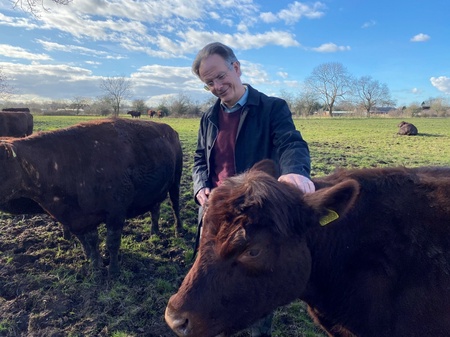I’ve been researching the ethics of farming animals for fifteen years now. That convinced me some time ago that industrial animal agriculture is highly problematic for farmed animals, as well as for human welfare and the climate and biodiversity crises. But details about the systemic cruelty current farming practice inflicts on farmed animals still have the capacity to make me fume. This month I was writing about how chicken are farmed and the issue that struck me was this: Did you know that the chickens used to breed chickens farmed for meat have to be kept hungry?
Judging by the response to the Twitter thread I wrote on the topic, this doesn’t seem to be widely known. It’s a big deal because freedom from hunger and thirst is the first of the ‘Five Freedoms’ that are widely recognised as a foundation of the welfare of animals under human control. So how have we ended up with a system of breeding that requires chickens to be continually hungry?
To get chickens farmed for meat to slaughter weight in the remarkably short time required in modern broiler systems (35–40 days), they have to eat a lot. They’re bred to have reduced signalling for satiety, the physiological response that tells you when you’ve eaten enough. With this weakened signalling, they feel hungry and keep on eating for longer. But this creates a problem.
The chickens used to breed broiler chickens must also have this weakened satiety signalling, so they can pass it onto their offspring. But they can’t be allowed to eat like a broiler chicken. That’s because chickens become so grossly overweight that they become physiologically unfit to breed.
So breeding chickens have to experience hunger like broiler chickens so that they pass on that characteristic to their offspring, but can’t be permitted to satisfy that hunger, because then they’d be unable to perform their breeding function. The consequence is that they have their feed restricted, so they feel hungry without being able to eat enough food to satisfy that hunger.
Hunger as a welfare issue is under-researched, but ‘there is ample evidence to highlight hunger as a major welfare issue in feed-restricted broiler breeders’ (Nicol et al., Farmed Bird Welfare Science Review, 2017). This is a big deal: it means that the breeding of broiler chickens is a systemic breach of a fundamental animal welfare principle.
In 1979, the UK Farm Animal Welfare Council formalised a statement of the ‘Five Freedoms’ of animal welfare, which has subsequently become a key reference point for the welfare of animals under human control. The first of those freedoms states that animals should have ‘freedom from hunger and thirst’. This means that the breeding of broiler chickens requires keeping birds used for breeding in a state that fails to satisfy a basic animal welfare principle. The problem is less severe with slower growing broiler chicken breeds, but is not eliminated.
This is by no means the only animal welfare problem with broiler chicken production, of course. Broiler chickens, like other intensively farmed animals, have very little ‘freedom to express normal behaviour’, which is the fourth freedom. But the need of the breeding system to keep chickens hungry is a very clear example of the way that current practice in farming chickens is at stark odds with very widely accepted norms of animal welfare.
So what follows from the very uncomfortable recognition that breeding chickens for meat requires chickens to be kept hungry? For me it’s a red flag warning us that good animal welfare is incompatible with current methods of breeding and farming chickens. This should give individuals and institutions concerned about animal welfare reason to reconsider their purchase and consumption of chicken. It would be good to count universities like Aberdeen among such institutions.
The recognition that it’s unethical to keep chickens hungry should also prompt a systematic rethink of systems of farming chickens for meat. To avoid the problem that requires breeding chickens to be kept hungry would mean dismantling key elements of the current system and returning to much slower growing breeds of chickens, which would have many advantages for other aspects of their welfare.


